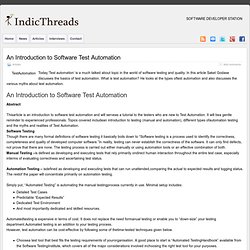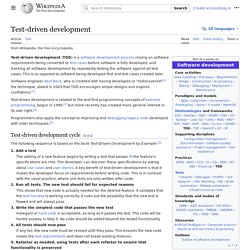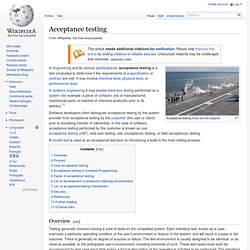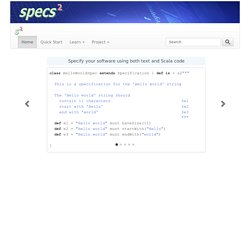

FitNesse. Selenium web application testing system. Welcome to JUnit.org! Database Testing. Database Testing Richard Dallaway notes about database unit testing inspired me the realization of the DbUnit framework.

I think this is a very good text about this subject. Hopefully he gave me the permission to present excerpts from his notes here. The original text is much longer and I strongly suggest you to read it as well. See resources for reference to it. - Manuel Laflamme Unit testing database These are my notes on how I've gone about unit testing database functionality. The problem is this: you have a SQL database, some stored procedures, and a layer of code sitting between your application and the database.
Why bother? I'm guessing some, if not a lot, of database development goes like this: set up database, write code to access database, run code, do a SELECT to see if the records showed up in the database. The problem with visual inspection is this: you don't do it often, and you don't check everything every time. You need [multiple] databases The production database. HttpUnit Home. Specification by Example. Intro to SW Test Automation. Today,‘Test automation’ is a much talked about topic in the world of software testing and quality.

In this article Saket Godase discusses the basics of test automation. What is test automation? He looks at the types oftest automation and also discusses the various myths about test automation. Software testing. Software testing is an investigation conducted to provide stakeholders with information about the quality of the software product or service under test.[1] Software testing can also provide an objective, independent view of the software to allow the business to appreciate and understand the risks of software implementation.

Test techniques include the process of executing a program or application with the intent of finding software bugs (errors or other defects), and verifying that the software product is fit for use. Software testing involves the execution of a software component or system component to evaluate one or more properties of interest. In general, these properties indicate the extent to which the component or system under test: As the number of possible tests for even simple software components is practically infinite, all software testing uses some strategy to select tests that are feasible for the available time and resources. Test-driven development. Test-driven development (TDD) is a software development process that relies on the repetition of a very short development cycle: requirements are turned into very specific test cases, then the software is improved to pass the new tests, only.

This is opposed to software development that allows software to be added that is not proven to meet requirements. American software engineer Kent Beck, who is credited with having developed or "rediscovered"[1] the technique, stated in 2003 that TDD encourages simple designs and inspires confidence.[2] Test-driven development is related to the test-first programming concepts of extreme programming, begun in 1999,[3] but more recently has created more general interest in its own right.[4] Behavior Driven Development. In software engineering, behavior-driven development (abbreviated BDD) is a software development process based on test-driven development (TDD).[1][2] Behavior-driven development combines the general techniques and principles of TDD with ideas from domain-driven design and object-oriented analysis and design to provide software developers and business analysts with shared tools and a shared process to collaborate on software development,[1][3] with the aim of delivering "software that matters".[4] Although BDD is principally an idea about how software development should be managed by both business interests and technical insight, the practice of BDD does assume the use of specialized software tools to support the development process.[2] Although these tools are often developed specifically for use in BDD projects, they can be seen as specialized forms of the tooling that supports test-driven development.

Unit testing. In computer programming, unit testing is a method by which individual units of source code, sets of one or more computer program modules together with associated control data, usage procedures, and operating procedures are tested to determine if they are fit for use.[1] Intuitively, one can view a unit as the smallest testable part of an application.

In procedural programming, a unit could be an entire module, but it is more commonly an individual function or procedure. In object-oriented programming, a unit is often an entire interface, such as a class, but could be an individual method.[2] Unit tests are short code fragments[3] created by programmers or occasionally by white box testers during the development process. Ideally, each test case is independent from the others. Substitutes such as method stubs, mock objects,[4] fakes, and test harnesses can be used to assist testing a module in isolation. Benefits[edit] Find problems early[edit] Acceptance testing.
In systems engineering it may involve black-box testing performed on a system (for example: a piece of software, lots of manufactured mechanical parts, or batches of chemical products) prior to its delivery.[1] Software developers often distinguish acceptance testing by the system provider from acceptance testing by the customer (the user or client) prior to accepting transfer of ownership.

In the case of software, acceptance testing performed by the customer is known as user acceptance testing (UAT), end-user testing, site (acceptance) testing, or field (acceptance) testing. Overview[edit] Testing generally involves running a suite of tests on the completed system. Each individual test, known as a case, exercises a particular operating condition of the user's environment or feature of the system, and will result in a pass or fail outcome. Specs2 @ GitHub. Specify your software using both text and Scala code class HelloWorldSpec extends Specification { def is = s2""" This is a specification for the 'Hello world' string The 'Hello world' string should contain 11 characters $e1 start with 'Hello' $e2 end with 'world' $e3 """ def e1 = "Hello world" must haveSize(11) def e2 = "Hello world" must startWith("Hello") def e3 = "Hello world" must endWith("world") } Use different styles of specifications.

Cucumber - Making BDD fun. Cuke4Ninja: The Secret Ninja Cucumber Scrolls.